
Theodor Seuss Geisel was an American children's author and cartoonist. He is known for his work writing and illustrating more than 60 books under the pen name Dr. Seuss. His work includes many of the most popular children's books of all time, selling over 600 million copies and being translated into more than 20 languages by the time of his death.

The Cat in the Hat is a 1957 children's book written and illustrated by American author Theodor Geisel, using the pen name Dr. Seuss. The story centers on a tall anthropomorphic cat who wears a red and white-striped top hat and a red bow tie. The Cat shows up at the house of Sally and her brother one rainy day when their mother is away. Despite the repeated objections of the children's fish, the Cat shows the children a few of his tricks in an attempt to entertain them. In the process, he and his companions, Thing One and Thing Two, wreck the house. As the children and the fish become more alarmed, the Cat produces a machine that he uses to clean everything up and disappears just before the children's mother comes home.
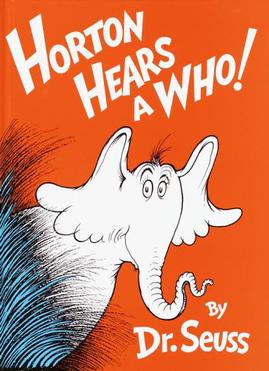
Horton Hears a Who! is a children's book written and illustrated by Theodor Seuss Geisel under the pen name Dr. Seuss. It was published in 1954 by Random House. This book tells the story of Horton the Elephant and his adventures saving Whoville, a tiny planet located on a speck of dust, from the animals who mock him. These animals attempt to steal and burn the speck of dust, so Horton goes to great lengths to save Whoville from being incinerated.

Green Eggs and Ham is a children's book by Dr. Seuss. It was published by the Beginner Books imprint of Random House on August 12, 1960. The book follows Sam-I-am as he follows an unnamed man, repeatedly asking him if he would like to try some green eggs and ham before the man eventually tries it and likes it. Seuss began writing Green Eggs and Ham after his editor Bennett Cerf bet him $50 that he could not write an engaging children's book with a vocabulary of 50 words. Finding the challenge difficult, Seuss used notes, charts, and checklists to keep track of his progress. The book covers themes of conflict between individuals, though Seuss has said that it lacks any deeper meaning. Green Eggs and Ham was widely praised by critics for its writing and illustration, and challenge of writing a book in 50 words is regarded as a success. The book has been the subject of multiple adaptations, including a television series of the same name in 2019.

The Wubbulous World of Dr. Seuss is an American children's puppet television series based on characters created by Dr. Seuss, produced by The Jim Henson Company. It aired from October 13, 1996, to May 15, 1998, on Nickelodeon. It combines live puppets with digitally animated backgrounds, and in its first season, refashioning characters and themes from the original Dr. Seuss books into new stories that often retained much of the flavor of Dr. Seuss' own works.

And to Think That I Saw It on Mulberry Street is Theodor Seuss Geisel's first children's book published under the name Dr. Seuss. First published by Vanguard Press in 1937, the story follows a boy named Marco, who describes a parade of imaginary people and vehicles traveling along a road, Mulberry Street, in an elaborate fantasy story he dreams up to tell his father at the end of his walk. However, when he arrives home, he decides instead to tell his father what he actually saw—a simple horse and wagon.
The Dr. Seuss National Memorial Sculpture Garden is a sculpture garden at the Quadrangle in Springfield, Massachusetts, which honors Theodor Seuss Geisel, better known as Dr. Seuss, who was born in Springfield in 1904. The monument was designed by Lark Grey Dimond-Cates, the author's stepdaughter, and created by sculptor and artist Ron Henson.

Oh Say Can You Say? is a children's book written and illustrated by Theodor Geisel under the pen name Dr. Seuss, and published in 1979 by Random House. It is a collection of 22 tongue-twisters. It was Dr. Seuss's last beginner book to feature his own illustrations.
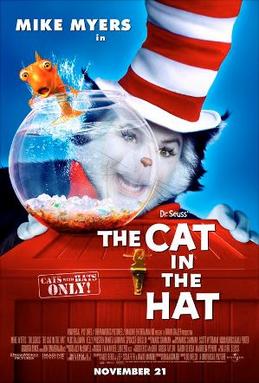
The Cat in the Hat is a 2003 American fantasy comedy film directed by Bo Welch in his directorial debut and written by Alec Berg, David Mandel and Jeff Schaffer. Loosely based on Dr. Seuss's 1957 book of the same name, it was the second and final live-action feature-length Dr. Seuss adaptation after How the Grinch Stole Christmas (2000). The film stars Mike Myers in the title role along with Alec Baldwin, Kelly Preston, Dakota Fanning, Spencer Breslin, Amy Hill and Sean Hayes in supporting roles.
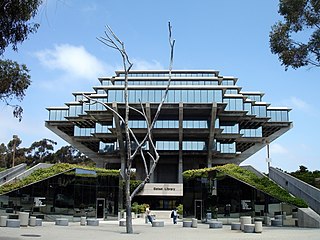
Geisel Library is the main library building of the University of California, San Diego. It is named in honor of Audrey and Theodor Seuss Geisel, better known as children's author Dr. Seuss. The building's distinctive architecture, described as occupying "a fascinating nexus between brutalism and futurism", has resulted in its being featured in the UC San Diego logo and becoming the most recognizable building on campus.
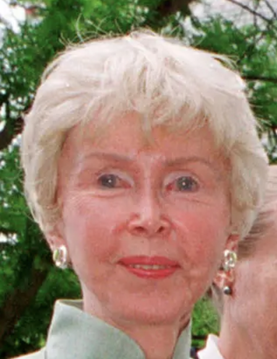
Audrey Grace Florine Stone was the second wife of American children's book author Theodor Geisel, to whom she was married from 1968 until his death in 1991. She founded Dr. Seuss Enterprises in 1993, and was President and CEO of the company until her death in 2018.
The Cat in the Hat is an American animated musical television special originally broadcast March 10, 1971 on CBS. It was based on the 1957 Dr. Seuss children's story of the same name, and produced by DePatie–Freleng Enterprises. With voices by Allan Sherman and prolific vocal performer Daws Butler, this half-hour special is a loose adaptation of the book with added musical sequences.
Helen Marion Palmer Geisel, known professionally as Helen Palmer, was an American children's writer, editor, and philanthropist. She was also the Founder and Vice President of Beginner Books, and was married to fellow writer Theodor Seuss Geisel, better known as Dr. Seuss, from 1927 until her death.
Philip W. Nel is an American scholar of children's literature and University Distinguished Professor of English at Kansas State University. He is best known for his work on Dr. Seuss and Harry Potter, which has led to him being a guest on such media programs as CBS Sunday Morning, NPR's Morning Edition,Talk of the Nation, and CNN's Don Lemon Tonight.

A Fish Out of Water is a 1961 American children's book written by Helen Palmer Geisel and illustrated by P. D. Eastman. The book is based on a short story by Palmer's husband Theodor Geisel, "Gustav, the Goldfish", which was published with his own illustrations in Redbook magazine in June 1950.
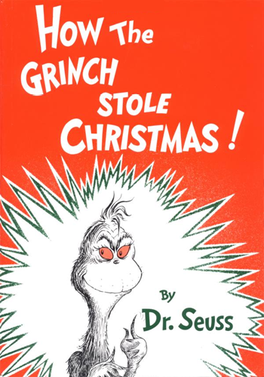
How the Grinch Stole Christmas! is a Christmas children's book by Theodor "Dr. Seuss" Geisel written in rhymed verse with illustrations by the author. It follows the Grinch, a cranky, solitary creature who attempts to thwart the public's Christmas plans by stealing Christmas gifts and decorations from the homes of the nearby town of Whoville on Christmas Eve. Miraculously, the Grinch realizes that Christmas is not all about money and presents.
Theodor Seuss Geisel, better known as Dr. Seuss, published over 60 children's books over the course of his long career. Though most were published under his well-known pseudonym, Dr. Seuss, he also authored a certain amount of books as Theo. LeSieg and one as Rosetta Stone.
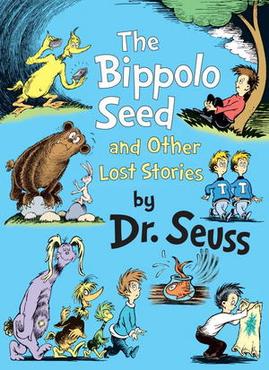
The Bippolo Seed and Other Lost Stories is a collection of seven illustrated stories by children's author Dr. Seuss published by Random House on September 27, 2011. Though they were originally published in magazines in the early 1950s, they had never been published in book form and are quite rare, described by the publisher as "the literary equivalent of buried treasure". The stories were discovered by Charles D. Cohen, a Massachusetts dentist and a Seuss scholar and biographer, who also wrote an introduction to the collection.
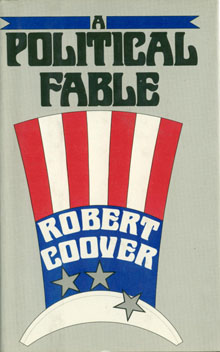
A Political Fable is a 1980 novella by Robert Coover. It was originally published, in slightly different form, in New American Review in 1968, under the title "The Cat in the Hat for President" and re-released under that same title in 2017.

The Cat in the Hat is a 2003 2.5D platform game for PlayStation 2, Xbox, Microsoft Windows and Game Boy Advance. The PlayStation 2 and Xbox versions were developed by Magenta Software. The Windows and Game Boy Advance versions were developed by Digital Eclipse. All versions of the game were published by Vivendi Universal Games. It is based on the 2003 film of the same name, which was released shortly after the game. A version for the GameCube was planned, but was never released. The Windows version is compatible with Windows 98, Windows ME, Windows 2000, Windows XP, Windows Vista, and Windows 7. It is not compatible with Windows 95 or earlier versions of Windows or Windows 8 and later versions of Windows.















